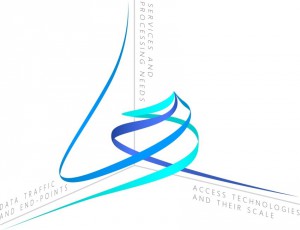The ever increasing traffic volume originating from Internet of Things (IoT) appliances as well as media-rich mobile applications and services is expected to push the limits of 5G access infrastructures, with some experts expecting up to 1,000 times the volume of traffic than what current 3G/4G deployments carry. This increased volume is to be accompanied with stringent low-delay requirements, all the while trying to reduce investment and operational costs in an increasingly competitive network operator market.
Technological enhancements in the wireless domain are of course pivotal to facing such performance and scalability challenges, and mandate for the ability to fully harness capillary distributed antennas (for massive MIMO, beamforming, interference cancellation) via cooperative multi-point processing and control primitives.
The ability to virtualize signal processing tasks, and to execute them inside centralized computational environments directly deployed within the network infrastructure itself will enable such technologies to profit from the rate of innovation of typical software-based solutions.
Further, well-designed basic processing primitives and application programming interfaces would allow deployment of advanced algorithms which are today blocked by the proprietary nature of the involved components.
5G networks will face issues beyond performance and scalability. SUPERFLUIDITY further plans to offer a converged solution to counter the complexity emerging from three forms of challenging heterogeneity:
- Heterogeneous data traffic and end-points make proper planning and prediction of loads incredibly hard.
- Heterogeneity in services and processing needs: operators have largely recognized the need to transform the wireless access network from a bit pipe to a “smart” pipe. A network that is able to instantiate platform-agnostic software-based processing when needed, where needed, would open up seemingly endless possibilities.
- Heterogeneity in access technologies and their scale. 5G networks should become access-agnostic: specific wireless or wired technology should be treated as “just a bunch of accesses” (JBOAs), and seamlessly exploited (switched) so as to offer an “always best served” model down to a per-application level of granularity (rather than users).
All of these challenges point to the need for a new convergence model well beyond the “everything-on-IP” convergence that paved the way in past research efforts and that has already been implemented, to a large practical extent, in current 4G network deployments.
Concretely, we will accomplish this through a “decoupled” approach which identifies and abstracts re-usable network primitives, so as to hide complexity inside: i) their (vendor-specific) adaptation to the specific technologies and hardware, and inside ii) specifically devised cloud-like technologies providing the relevant (distributed and edge-based) dynamic programming, scaling, execution and provisioning environment.
What SUPERFLUIDITY targets is the identification of elementary and reusable network and processing “primitives”, as well as provisioning “elements”, and their high performance software-based implementation for maximum portability, so as to permit us to rapidly deploy possibly widely different network services where they are needed.
In our view, a specific 5G network deployment should comprise the combination of:
- Elementary radio, packet, and flow processing primitives and events, formally specified and described independently of the specific underlying hardware, but implemented and automatically selected/instantiated so as to match the underlying hardware facilities while taking advantage of the relevant accelerators (e.g., GPUs or FPGAs) if/when available.
- Platform-agnostic node-level and network-level “programs” describing how these primitives interact, communicate, and connect to each other so as to give rise to specific (macroscopic, and formerly monolithic) node components, network functions and services.
- A computational and execution environment, supporting the execution (and deployment) of such “programs” and the relevant coordination of the signal/radio/flow/network processing primitives.
With this, operators will formally describe a desired network service as a composition of platform-agnostic, abstract elementary processing blocks; vendors will be in charge of providing efficient software implementations of such elementary blocks, possibly casting them to underlying hardware accelerated facilities; and the (cloud based) infrastructure will provide the brokerage services to match the design with the actual underlying hardware, to control and orchestrate the execution of the elementary blocks comprising the designed service, and to permit dynamic and elastic provisioning of supplementary dedicated computational, storage, and bandwidth resources to the processing components loaded with peak traffic. In short, we believe that one of the project’s major contributions will be applying this architectural approach to 5G networks to create the “glue” that can unify heterogeneous equipment and processing into one dynamically optimized, superfluid, network.

